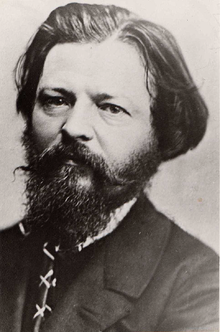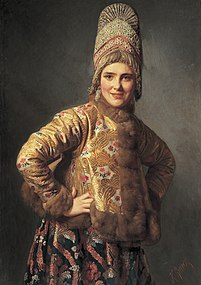Carl Wenig
Carl Wenig | |
|---|---|
 Photograph c.1870 | |
| Born | February 14, 1830 |
| Died | January 24, 1908 (aged 77) |
| Resting place | Novodevichy Cemetery, Saint Petersburg |
| Education | Member Academy of Arts (1860) Professor by rank (1862)[1] |
| Alma mater | Imperial Academy of Arts (1853)[1] |
| Known for | Painting |
| Style | Academism |
| Awards | |
Carl Bogdanovich Wenig or, in German, Carl Gottlieb Wenig (Russian: Карл Богданович Вениг; 26 February 1830 – 6 February 1908) was a Baltic-German painter of historical and religious scenes. For many years, he was a professor at the Imperial Academy of Arts.
Biography[edit]
His father, Gottlieb (1804-1874), was a music teacher and organist at St. Nicholas' Church. His mother, Agathe (1808-1895), was an amateur artist and the aunt of Peter Carl Fabergé.[2] From 1844 to 1853, he studied at the Imperial Academy of Arts with Fyodor Bruni. During his time there, he won several medals, including a gold medal for his depiction of Esther before Ahasuerus.[3] Upon graduating, he was awarded a stipend that enabled him to continue his studies in Rome, where he remained for six years.[2]
In 1860, he was awarded the title of "Academician" for his painting "The Entombment". Two years later, he was recognized as an Artist of Historical Painting on the strength of his depiction of two angels proclaiming the death of Sodom.[3] He began to teach drawing at the Academy that same year.
In 1869, he became an Associate Professor and was promoted to a fully tenured Professor of the second-degree in 1876. He was advanced to the first-degree in 1888. After 1871, he served as a member of the Academy's governing board. In addition to his canvases, he created several decorative murals and icons at the Cathedral of Christ the Saviour.[2]
His brothers, Bogdan and Pyotr (1849-1888) also became painters.
Selected paintings[edit]
-
Burial of Jesus, 1859
-
Last Minutes of the False Dmitri, 1879
-
Nurse Visiting a Sick Child, 1886
-
Ivan the Terrible and Agrippina Chelyadnina, 1886
-
Russian Girl in Folk Costume, 1889
References[edit]
- ^ a b c Kondakov 1915, p. 36.
- ^ a b c Biographical notes Archived 2019-10-08 at the Wayback Machine @ RusArtNet.
- ^ a b Brief biography @ Biografiya.ru
Literature[edit]
- Bogdan, Veronika-Irina T. [in Russian]; et al. (2003). Russian Academy of Arts, Moscow; et al. (eds.). Немцы и Академия художеств (exhibition catalog) (in Russian). Moscow: Russian Academy of Arts Museum. pp. 37–39, 77; cat. nos. 42–44, 170. OCLC 886361785.
- Gudymenko, Yuri Y. (2022). "Wenig". In Beyer, Andreas; Savoy, Bénédicte & Tegethoff, Wolf (eds.). Allgemeines Künstlerlexikon (in German). Vol. 115. Berlin, Boston: De Gruyter. pp. 477–479. ISBN 978-3-11-055066-5. OCLC 1286914467.
- Kondakov, Sergei N. [in Russian] (1915). Юбилейный справочник Императорской Академии художеств. 1764–1914 (in Russian). Vol. 2. Saint Petersburg: Golike and Vilborg. p. 36. OCLC 707072219.
- Neumann, Wilhelm (1902). Baltische Maler und Bildhauer des XIX. Jahrhunderts (in German). Riga: A. Grosset. pp. 108–111. OCLC 25471919. Archived from the original on November 10, 2021.
- Polovtsov, Anatoly V. [in Russian] (1904). Полвека служения искусству: Профессор К. Б. Вениг, 1853–1903 (in Russian). Moscow: Typography of the Moscow University.
- Popova-Yatskevich, Yelena G. (2015). "Российские Вениги". In Sakharov, Igor V. (ed.). Выходцы из Германии и их российские потомки [Einwanderer aus Deutschland und ihre Nachkommen in Russland] (conference papers) (in Russian). St. Petersburg: Presidential Library. pp. 351–366. ISBN 978-5-905273-44-5.
External links[edit]
![]() Media related to Carl Wenig at Wikimedia Commons
Media related to Carl Wenig at Wikimedia Commons
- Members of the Imperial Academy of Arts
- Academic staff of the Imperial Academy of Arts
- Imperial Academy of Arts alumni
- Awarded with a large gold medal of the Academy of Arts
- 1830 births
- 1908 deaths
- Artists from Tallinn
- People from the Governorate of Estonia
- Baltic-German people
- 19th-century painters from the Russian Empire
- Russian male painters
- Russian genre painters
- Russian history painters
- 19th-century male artists from the Russian Empire





